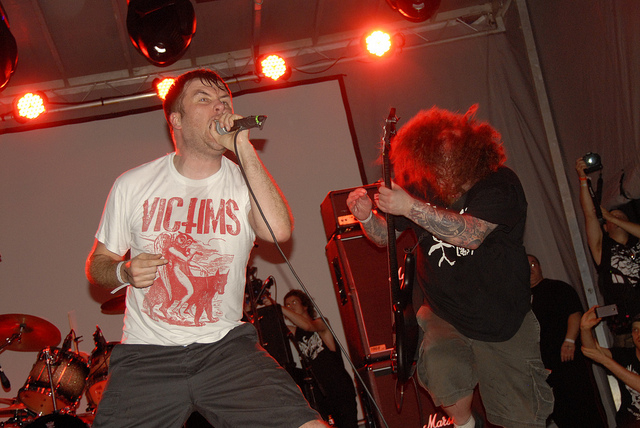There’s no more overused an adjective than legendary. ‘Legend’ used to be reserved those men and achievements that surpassed the norms of everyday experience. Now it is called into service to validate everything from the engine of a Dodge pickup truck to the onion rings at the local diner. If ever the term was properly applied, it would be to Jon “Metalion” Kristianson and his Slayer fanzine. In 2011, Brooklyn’s Bazillion Points Books collected the issues of Slayer, and paired them with extensive commentary from Kristiansen himself, creating an important document about the darkest corners of underground metal.
Heavy metal experienced a rebirth in the 1980s, which is frequently misunderstood. By 1985 the primal, simplifying force of Black Sabbath had spent itself, and the hair and makeup of bands like Mötley Crüe, Ratt, and Poison were the order of the day. In these years, underground metal grew up. It followed a path similar to that of hardcore punk, adopting a paired down, no bullshit approach, as a means of both reaching back to the authentic basis of the style, while at the same time creating a space for extra- (and anti-) social identity formation.
Metalion and Slayer were central figures in this rebirth. Based in the Norwegian town of Sarpsborg, Kristiansen was confronted with the problems of alienation and isolation so common among adolescents born far from the metropolitan centers of the industrialized world. His response was to exercise his own creativity while making use of the networks of communication available to him. In those days this amounted to trading cassettes among bands and other enthusiasts for the nascent extreme metal scene. Metalion was, by his own estimation, one of the most prolific correspondents and tape traders of that era. According to Kristianson, he sent out around 30,000 letters in the decade following 1983.
The growth of this scene in urban areas (particularly in Sweden) has been well documented, for instance books such as Swedish Death Metal by former Insision bassist Daniel Ekeroth. The history of Metalion’s Slayer, and of his creation of a network of correspondents that quite literally spanned the globe, describes the trajectory of the extreme metal underground from a perspective that is both external and internal. Metalion did not have regular, day to day access to spaces in which the urban metal scenes (such as those in Stockholm or Olso) percolated. But the web of connections that he created put him at the center of a stylistic and ideational world of extreme metal.
As an artifact of the underground metal scene, Slayer itself was the stuff of legend. In an era when the “thank you” lists that accompanied records acted as a means of solidifying associative networks, Metalion and Slayer were ubiquitous. From Napalm Death to Entombed, from Sadistik Exekution to Mayhem, there seemed to be no corner of the underground metal community beyond their reach. More than just documenting various points of interest, Slayer was a finger on the pulse of a multifaceted developing creative enterprise. Bands such as the aformentioned Mayhem, Morbid Angel, and Entombed were featured repeatedly, tracking their creative development and allowing readers to keep up to speed.
There is an element of vulnerability to Metalion, that makes his narrative both attractive and plausible. Strangely, for a guy who was personally acquainted with church burners, grave violators, and murderers, Metalion confesses to being intimidated by the punk rockers at a Doom show in 1988.
One of the most fascinating aspects of Metalion’s life in underground culture is the connection that he forged early on with figures who would figure prominently in the Norwegian black metal scene. Since the spectacular series of killings and church burnings brought them to prominence in the mid-1990s, the Norwegian black metal scene has been the subject of a wide range of appraisals. From Moynihan and Søderlind’s fawning Lords of Chaos to the recent spate of documentaries, such as Aaron Aites and Audrey Ewell’s Until the Light Takes Us, the voices that one hears tend to be those with a stake in the meaning and significance of the history. The virtue of Metalion’s voice is that is it based in his own broader tastes, but also in the humanity of his relationships.
Metalion met Euronymous in the earliest days of Mayhem. He became friends with Per Yngve “Dead” Ohlin when he moved from Sweden to join the band and watched him struggle with poverty in a foreign environment. In Kristianson’s telling, the pretension and agendas of Mayhem’s early history are stripped away. His explanation of the early role of corpse paint in the black metal scene illustrates this:
“Those guys [Mayhem] never went out to shows wearing corpse paint. Euronymous did, but not until much later. I think that some misconceptions grew after some photos circulated which were taken in the basement of Euronymous’ parents’ house. In the pictures, the Mayhem guys are fully decked out, and in the background is an ordinary living room, which gave people the impression that they lounged around in corpse paint, which was never true.”
Lacking the desire to make the early history of Norwegian black metal into anything more than it was, Metalion speaks in a voice now bemused, now tragic. He explanation of the death by suicide of Pelle Ohlin is in many respects more objective than that presented by some other contemporaries. For him, unlike for those in the band itself, Per Yngve was principally a friend, rather than someone whose peculiarities can be exploited. Kristiansen’s telling of his experience of cleaning blood off the walls of the room where Ohlin killed himself, while Ohlin’s bandmate Euronymous made jewelry out of pieces of the dead man’s skull, is one of the most compelling moments in the narrative. The contrast between Metalion’s humane reactions, his inability to mourn the loss of his friend, presents a powerful contrast to the self-serving and self-involved responses of Ohlin’s bandmates.
Metalion: The Slayer Mag Diaries provides the reader with a wealth of information. The reprints of the issues of Slayer itself are crucial, given that the originals were never seen by more than a few thousand people worldwide. Coupled with Metalion’s biographical narrative, the reader is provided with a level of human detail that makes the underground metal scene into a human enterprise rather than leaving it to the self promotion of the bands that composed the business end of the scene.
This in itself is unusual. The history of underground scenes is rife with the retellings of band members, composed in the key of the self promotion implicit in being in a band in the first place. This is particularly true of the underground metal community, with its we’re-the best because we-say-we are ideology. Two years after its initial English-language publication, Metalion remains of intense interest, both for scene vets, and those who curious about its various histories. Here’s to more books like it.
Photograph courtesy of Metal Chris. Published under a Creative Commons license.





